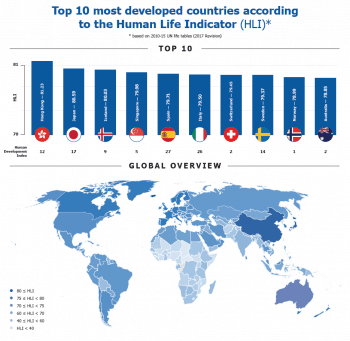New survival-based measure for wellbeing
Imagine an extreme scenario where half of a country’s population live until the age of 90, but the other half die at 30. Using conventional methods, the life expectancy of that population will be put at 60 years – the same as in the arguably better situation where all members of the population lived to age 60. The Human Life Indicator (HLI) developed by researchers from IIASA can be used to make a distinction between these two scenarios.
Early attempts to quantify wellbeing focused solely on economic factors, such as Gross National Income per Capita. The more comprehensive Human Development Index (HDI) created by the UN in 1990, for example, added education and life expectancy as additional indicators and, despite being criticized for its statistical and conceptual flaws it is still widely used today. According to the researchers, one of the problems with the HDI however, is the redundancy of the three dimensions considered. They explain that dropping the education and economic dimensions in the HLI leads to a significant simplification without a notable loss of information.
The researchers found that their newly developed index sometimes produces different rankings of countries than the HDI. Norway, for instance, has been leading the HDI ranking for decades, in part due to their income from North Sea oil and gas, but it places 9th in the world when ranked according to the HLI. According to the researchers, this shows that the country’s high income has not been sufficiently translated into longer and more equal lifespans for its people. Similar disparities between the HDI and HLI rankings can be found for other developed countries and is publicly available on the IIASA website.

Figure 1: The top 10 most developed countries according to the Human Life Indicator (HLI) as based on the 2010-2015 UN life tables.
The HLI expresses wellbeing in terms of years of life, similar to life expectancy at birth but, unlike any other current measure, it takes not only the mean value into account, but also inequalities in longevity. Another advantage of the new index is that it can be calculated even when information about education and economic wellbeing is not available, which means that it can provide a measure for human development that goes back further than the introduction of the HDI in 1990. By evaluating the wellbeing in selected countries over time, the researchers also show that the behavior of the HLI reflects major political and economic events across the world in the last century, such as the world wars in European countries, or the Vietnam war in Asia. This can be useful in assessing progress towards the UN Sustainable Development Goal for reduced inequality (SDG10).
The researchers hope that their work will be useful in furthering discussions on how we think about the wellbeing of countries.





